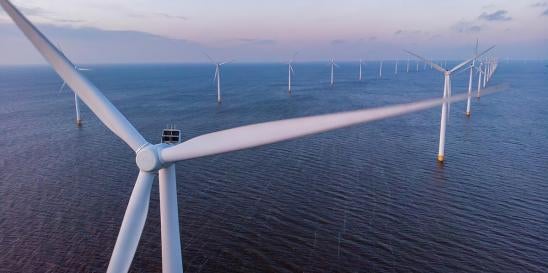2023 seems to have been a perfect storm for the offshore wind industry around the globe. Between permitting delays and grid connection hurdles, inflation and supply chain challenges all have led some developers wanting to renegotiate their previously agreed offtake deals or just to end their commitment under previously agreed offtake deals with the payment of fines. In other parts of the globe, we saw an uncapped negative bidding auction in Germany’s 7GW wind auction, and in the UK, we saw no offshore wind projects being awarded contracts for differences (CfDs) in Round 5. So, what will lay ahead for 2024?
My predictions are that the following five themes may emerge:
1. Bigger Wind Turbine Generators (WTGs)
It is no secret that cost pressures have played havoc with renewable project economics across the globe. In the current fast-growing offshore wind market, not only in Europe but also across the globe (including in the United States of America), increasing WTG nameplate capacity per turbine offers the opportunity for developers to reduce the cost of installation as well as operation and maintenance. Whilst there is some driving force from developers (and investors) for larger WTGs for offshore wind projects, are these drivers simply only going to lead to the creation of an unsustainable market or, at the very least, a market which does not result in lowering the cost of energy which is the overall aim of the developer/investor community (as well as the desire for the consumers who ultimately pay for the energy)?
The push for ever larger WTG has been (and continues to be) a very painful journey for the supply chain. Before the previous models are commercially profitable (after being fully vetted by relevant certification authorities), the desire for the new model with even larger nameplate capacity is requested. Whilst, at quick glance, some would say that the costs per megawatt are correlated to WTG size so the bigger the nameplate capacity of the WTG, the fewer foundations to install but, this oversimplification then forgets the real components to the offshore wind turbine – it will require bigger foundations, bigger blades, bigger factories (all the way down the supply chain) and, not to forget, the even larger installation vessels.
Therefore, the real issues with the pressure for WTGs with a larger nameplate capacity are twofold:
a. Can the larger WTGs be installed when there is a lack of installation vessels which would be capable of installing these WTGs; and
b. What is a sustainable long-term market for the offshore wind industry?
Last year, DNV[1] were commissioned to undertake a study as to the optimal offshore wind turbine size and confirmed that, whilst DNV “does not see any technical limitation for WTGs to grow in size beyond the current largest offshore WTG design, numerical analysis shows that further growth does not result in lowering the Levelised Cost of Energy (LCOE).”
The real issue for how big a WTG will be available for post-2030 projects is not what is technically feasible or even imaginable, but really what is economically sustainable for the market. The impact on the supply chain must be considered. Given that some of the subcontractors are making close to zero – if not zero – profit margin as it is, to then make design changes to embrace larger than 15 MW will cause even more supply chain issues. Bigger won’t necessarily be better if there isn’t an industry which can support the WTGs nor any vessels which are available for the transportation and the installation of WTGs in offshore locations. The one alternative is where floating offshore wind turbines feature more than they do. This market is still really in its infancy but would overcome the installation vessel issue.
If one wants the offshore wind market to be sustainable, in 2024 we would hope to see the easing of the pressure for creating even larger nameplate capacity than the current 12-15MW WTGs and the focus on standardization so that improvements can be made within the currently designed WTGs. Of course, this may not occur in all parts of the globe, as Chinese manufacturers are always striving to have larger WTGs than their Western competitors, so we have already seen a 16MW WTG installed in an offshore wind project in China, plus one Chinese manufacturer announced last month a new 22MW offshore model in development.
2. Developers’ Consolidation of Current Portfolios
Already evidenced by the activity in the second half of 2023 with Vattenfall’s decision to put its 1.4GW Norfolk Boreas project in the UK on hold and Ørsted, Shell/Ocean Wind (a joint venture between Engie and EDP) and Iberdrola shelving some of their projects in the USA and other developers declaring renewables impairments to their portfolios, 2024 will see developers taking a more cautious approach to consolidate their current portfolios. Whilst Vattenfall’s, Shell/Ocean Wind’s, Iberdrola’s and Ørsted’s decisions have occurred around a similar time, some of the impacts of inflation and overambitious tender for auction bids plus supply chain issues may not manifest themselves immediately. The market is predicted to not witness a host of projects being shelved, but it may cause delays to some projects and the need for developers to campaign to the relevant government agencies or attempt to put more of a squeeze on the supply chain (see further themes below).
3. Increased M & A Activity and New Market Entrants
The review of developers’ portfolios (as mentioned in the second factor above) is likely to lead to increased M & A activity in the market as developers reassess their portfolio and current mix of developing and operational projects and seek to divest some of their assets to free up capital for some of their earlier-stage developing projects (with a consolidation of their portfolios expected). The likely activity will be different for different developers – some developers/owners will consolidate their portfolio by either not adding new projects and/or prioritising certain projects in their portfolio for current vs later development. Other developers will seek to sell down interests to share the risk/reward, reconfigure their partnerships and rebalance their capital commitments in the offshore wind sector to better fit the different conditions in different parts of the globe.
Those looking at inward investment may not be limited to those traditionally expected, as we expect to see new entrants to the market. For example, a couple of weeks ago, we saw Octopus Energy launching a fund to invest £3 billion in offshore wind by the end of the decade. Also, it is expected some of the other infrastructure funds will widen their portfolios with green credentials via offshore wind investments.
4. Pressure on OEMs and Supply Chain Squeeze
OEMs have been hit hard over the last couple of years. All OEMs faced issues over the pandemic when project development slowed down, but since then things have not improved. All the major western OEMs have reported consecutive quarterly losses in their wind segments in the last year. This is no surprise given that costs have been reported to have increased by 40 per cent this year so most of the components that go into making an offshore wind farm from the WTGs to the cabling have been touched by inflation- busting price rises.
Whilst in the past, developers have squeezed suppliers, in 2024 we will start to see the shift in dynamics between the developers and the OEMs/supply chain. It is expected that the supply chain will not only wish to pass on the big increases in raw materials but also try to recover their margins. The shift in market dynamics may be like the early days of offshore wind projects where the OEMs hold much greater degree of power in dictating which of the projects they will want to be a part of, thus creating more of a reverse auction environment for developers. At the very least, the overall market realignment in 2024 will include realigned pricing and delivery commitments.
5. Pressure on Government Agencies
On 16 November 2023, the UK government announced some very welcomed news, increasing the subsidies available to offshore wind developers by up to two-thirds to revive new projects in a sector that is struggling with surging costs. The maximum price available in next year’s auction to build offshore wind farms will be 66 per cent higher than in the 2023 bidding round where next year’s offshore wind contracts will have a maximum strike price of £73 per MWh and for floating offshore wind farms, the price will be £176 per MWh, up from £116 per MWh.
Whilst, in the USA, the Bureau of Ocean Energy Management (BOEM) continues to issue approvals and meet pre-approval milestones for projects. Various states in the USA are now beginning to co-ordinate their solicitations better so this activity, together with the favourable taxation guidance on the Inflation Reaction Act, means that the government story in 2024 looks to continue to be favourable even as markets adjust.
As we saw with the recent developments with government agencies around the globe, there will be continued pressure to overhaul or refine the relevant auction process or, at the least, adjust the processes so that they consider the current issues facing the market especially linked with the high inflation costs and supply chain issues. There is likely to be continued pressure on government agencies to continue to closely interface with industry executives and potentially embrace some of the remedies suggested by them.
In summary, there may have been stormy waters in the offshore wind market in 2023, but 2024 is expected to be filled with interesting developments in this market all around the globe as all the market participants begin to adapt to the new market conditions which have resulted from the perfect storm in 2023.
[1] DNV Services UK Ltd report dated May 2022 “Optimal Offshore wind turbine size and standardisation study” commissioned by RVO (Netherlands Enterprise Agency at the request of TKI Wind op Zee (TKI Offshore Wind).



 i
i


